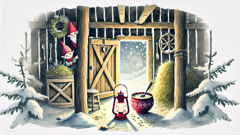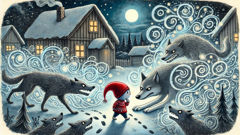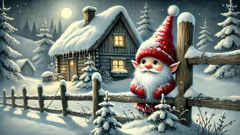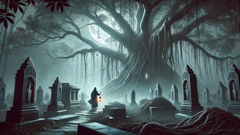Introduction
As winter deepens across the Norwegian countryside, the forests and fields surrender to a world of silent white. Snow rests on ancient pines, weighing down their branches like shawls pulled close for warmth. The air tastes of woodsmoke, and the early dusk brings a hush that feels older than the mountains themselves. In this land of fjords and frost, the people know the long, hard months test both body and spirit. Yet, as the solstice approaches and darkness lingers, hope flickers in every window—a candle to call back the sun, and perhaps, something more. For in Norway’s oldest tales, there lives a secret guardian: the Nisse. Some call him Tomte, a small, gnome-like being with a beard as white as new snow, a bright red cap, and eyes full of ancient mischief. He moves unseen through the shadows of barns and stables, tending animals, mending tools, and watching over those who show respect for the land. Legends say that a well-cared-for Nisse brings luck and prosperity; a neglected or insulted one, mischief or worse. Parents whisper the stories to children as the wind howls outside, each retelling weaving together caution, gratitude, and the promise that kindness never goes unnoticed. Across centuries, the Nisse has become more than myth—he’s a symbol of wisdom, hard work, and the enduring connection between humans and the world they shape. So, as the snow deepens and the Christmas star glimmers above, one family’s farm will soon discover just how real, and how wise, their secret guardian truly is.
I. The Farm at Solbakken: Shadows of Winter
Solbakken Farm lay nestled between pine-clad hills and a winding, frozen stream. Its red-painted barn and white-planked farmhouse had seen many winters, each one knitting together the lives within its walls more tightly than the year before. The Thorsen family—Maren, the widowed matriarch, her eldest son Jørgen, practical and strong, spirited eleven-year-old Liv, and their quiet youngest, Einar—knew how to survive the dark season. Yet this winter bit harder than any Maren remembered. Grain stores had spoiled in a summer storm, and two of their sheep had vanished just as the first snows fell. Each day, Jørgen rose before dawn to chop wood and break the ice on the well, while Maren baked coarse rye bread, careful to ration each loaf. Evenings, as the wind rattled the shutters, Liv would draw pictures in the frost on her window: little bearded figures in red hats, just like the ones from her grandmother’s stories. She’d whisper their names—Tomte, Nisse—hoping they might be listening. One night, after a particularly fierce blizzard, Liv crept down to the barn carrying a bowl of warm porridge drizzled with butter. Her grandmother had always said it was the Nisse’s favorite, and Liv didn’t want to take any chances. Inside, the cows shifted sleepily and the horses snorted as Liv set the bowl in a clean corner. For a moment, she thought she saw movement in the rafters—a flicker of red, a glimmer of eyes reflecting the lantern’s light—but it was gone before she could be sure. By morning, the porridge had vanished.

Despite the family’s efforts, misfortune lingered. Tools went missing, hens stopped laying, and Jørgen’s ax head snapped clean from its handle. Each setback gnawed at their hope. Maren worried over Liv’s thin cheeks and Einar’s growing silence. She tried to keep their spirits bright with tales of old Yule feasts and the wisdom of the Nisse, reminding her children that gratitude and respect could turn even the darkest winter. But one bitter morning, as Maren swept the threshold, she found a tangle of tiny muddy footprints trailing from the barn to the house—so small they could only belong to a creature from legend. That night, she joined Liv in setting out an extra bowl of porridge, this time with a careful bow and a whispered, “Thank you, Nisse, for watching over us.”
Strange things began to happen after that. A missing hammer turned up, perfectly mended, on the chopping block. The hens resumed laying, their eggs warm in nests lined with bits of red wool. Einar’s favorite mittens, lost for weeks, appeared on his pillow, smelling faintly of moss and pine. Even Jørgen’s spirits lifted as he found his boots dried and cleaned by the morning fire. The family started to believe—just a little—that something magical lingered among the shadows. Yet, as Christmas neared and the nights grew longer, a new challenge arrived: a pack of hungry wolves prowling the edge of the forest, their eyes glinting in the darkness. One evening, as the Thorsens huddled by candlelight, a gentle tapping sounded at the window. Liv opened it to find a single red feather caught on the sill and a note—written in careful, curling script—reading, “Trust the wisdom of the old ways. Prepare. Tonight.”
II. The Night of the Wolves: The Nisse’s Wisdom
Maren read the note again, fingers trembling. The words seemed to pulse with an energy that made the candle flame flicker. Jørgen fetched his father’s old hunting spear while Einar clung to Liv’s hand. Liv herself stared out into the night, her breath frosting on the glass, hoping to catch another glimpse of their mysterious friend. As darkness pressed close, a distant howl echoed across the fields—long, mournful, and full of hunger. The Thorsens moved quickly, shoring up the barn doors with planks, gathering the animals close, and scattering handfuls of ash around the threshold, just as Maren’s grandmother had taught her. Liv slipped outside once more, this time placing a red knitted scarf around the porch post and whispering thanks into the chill. All around them, the world was silent but for the wind and the distant howls growing bolder.

In the deepest part of the night, as the moon slipped behind ragged clouds, the wolves came. Their eyes shone in the snowlight as they circled the farmstead, drawn by the scent of livestock and the warmth of the house. Inside, the Thorsens waited, hearts pounding. Then, just as a heavy paw thudded against the barn door, a sudden gust of wind swept through the yard—carrying with it a swirling, shimmering mist. In that haze, Liv saw shapes moving: small footprints darting through the snow, a flicker of red darting here and there. The wolves snarled and bristled, but each time they advanced, something unseen tugged at their tails or scattered snow into their eyes. Einar gasped as the barn door rattled, but then held fast—bolted by a knot of red wool that seemed to glow against the wood.
Out of the mist stepped the Nisse himself. He was barely as tall as a fence post, but his beard was long and his eyes ancient and bright. He wore boots of birchbark, a jacket made from moss and squirrel fur, and his red cap was pulled down low over his brow. The Nisse looked straight at Liv, his gaze sharp but kind, and nodded once. Then he turned to face the wolves. Raising a crooked staff, he tapped it thrice on the frozen ground. The earth rumbled softly, and the wind picked up, swirling around the wolves in a dance of snow and light. For a moment, it looked as if the wolves were surrounded by a ring of tiny shadows—other Nisser, perhaps, or spirits of the land—all guarding the farm with silent determination.
The wolves, bewildered and frightened by this otherworldly defense, slunk back into the trees, leaving only their tracks behind. The mist faded as quickly as it had come. The Nisse stood alone in the yard, his breath steaming in the cold. Liv stepped outside, heart pounding, and approached him with cautious awe. She knelt in the snow and offered her hand. The Nisse took it in his own—rough, warm, surprisingly strong. “Thank you,” Liv whispered. The Nisse smiled, his eyes twinkling like starlight. “The old ways remember kindness,” he said in a voice like wind through pine needles. “You care for your home, your land, and for those unseen. That is wisdom.” He pressed something small and hard into Liv’s palm: a silver acorn. “Keep this close. It will remind you that fortune favors the grateful.”
With that, the Nisse vanished into the shadows. Liv stood in the yard long after he’d gone, feeling the weight of his gift and the warmth of hope kindling in her chest. The rest of the family joined her, marveling at the peace that had returned to Solbakken Farm. From that night on, no wolf troubled their barn again. Each winter, the Thorsens set out porridge with butter, careful not to forget. And each spring, their fields seemed greener, their animals stronger, their lives blessed in quiet, enduring ways.
Conclusion
Over the years, Solbakken Farm thrived, its fields lush and animals healthy even through the hardest winters. Stories of the Nisse—his wisdom, his mysterious interventions, and the silver acorn—became part of the Thorsens’ family lore. Liv grew up teaching her own children to respect both seen and unseen helpers: to leave a bowl of porridge at Yule, to care for every tool and animal, and to greet each dawn with gratitude. The legend of the Nisse traveled beyond Solbakken, echoing in neighboring villages where people whispered of footprints in the snow and found small gifts left at their doors. In time, the story became as much a part of Norwegian Christmas as the flicker of candles or the scent of pine. And so, even as centuries passed and the world changed around them, the wisdom of the Nisse—of kindness, respect for the land, and the power of gratitude—remained. Each winter solstice, when darkness pressed close and hope seemed distant, a single red cap might be glimpsed in the moonlit snow, reminding all who saw it that the smallest guardian can cast the brightest light.













